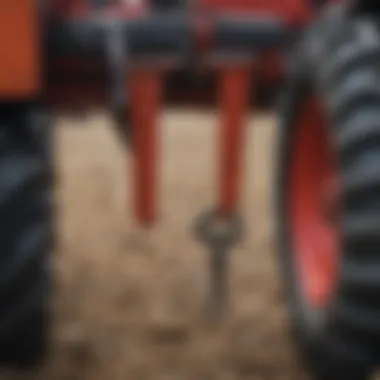Comprehensive Guide to Sleeve Hitch Implements in Agriculture


Intro
Understanding sleeve hitch implements is critical for anyone involved in agriculture today. These tools have evolved over the years to address the challenges faced by farmers in various applications. The sleeve hitch serves as a significant connection between tractors and different farming implements. This relationship enhances the efficiency of agricultural tasks while simplifying the process of changing tools and attachments.
In this article, we will explore key concepts and terminology related to sleeve hitch implements, current trends and innovations in this field, and their practical applications in today’s agriculture. Through this exploration, we aim to provide a comprehensive understanding of how sleeve hitch technology contributes to modern farming practices.
Preface to Sleeve Hitch Implements
In the realm of modern agriculture, the utilization of sleeve hitch implements plays a crucial role in optimizing farming efficiency and effectiveness. These implements are designed to enhance the capabilities of agricultural machinery, providing farmers with versatile tools to tackle various land management tasks. Understanding sleeve hitch systems not only helps in maximizing productivity but also contributes to the sustainability of farming practices. This section will explore the definition, historical context, and significance of these implements in contemporary agricultural operations.
Definition and Overview
A sleeve hitch is a type of coupling system used in agricultural equipment that allows for the easy attachment and detachment of various implements. These implements range from tillers and plows to seeders and cultivators. The design of the sleeve hitch system allows for an adjustable height and angle, making it easier for farmers to work on different terrains and conditions. The primary purpose of a sleeve hitch implementation is to facilitate efficient agricultural practices by enabling the operator to quickly switch between tools as required.
Sleeve hitch implements foster versatility. Farmers can adapt the machinery based on specific crop needs or land types. This adaptability is key to maintaining productivity throughout the growing season, as each phase of crop cultivation may require different tools.
Historical Context
The evolution of sleeve hitch implements is rooted in the advancement of agricultural technology. Early farming relied heavily on manual labor and animal-drawn tools. As mechanization took root in the early 20th century, the need for more efficient attachment systems became clear. Farmers required ways to simplify their equipment management and improve their operational speed.
The introduction of the sleeve hitch marked a significant stride forward. Initially used in smaller-scale farming, the concept gained traction among larger operations due to its many advantages. The flexibility in equipment arrangement, along with the ease of detachment, empowered farmers to become more efficient and strategic about their labor and time management.
Today, sleeve hitch implements have transformed into essential components of modern agricultural practices, underscoring the historical journey from basic farming to present-day advancements. The ongoing innovations and adaptations reflect the learning processes within the agricultural sector, signaling a continual pursuit of better farming solutions.
Understanding the evolution of sleeve hitch technology contextualizes its importance in today's agricultural practices.
Mechanics of Sleeve Hitch Systems
Understanding the mechanics of sleeve hitch systems is essential for anyone involved in agriculture. These systems are crucial for the effective functioning of various agricultural implements. They ensure that the implements can be attached seamlessly to tractors, improving efficiency in tasks like tilling, plowing, or planting. The mechanics involve several components and principles that together create a reliable and functional system.
Structural Components
Frame Design
Frame design is vital in providing the structural integrity of sleeve hitch systems. It supports the entire assembly and directly impacts the performance of attached implements. A strong frame design typically features a robust construction using durable materials like steel. This ensures longevity under heavy use. Moreover, a well-thought-out design encourages the even distribution of stress, reducing the risk of failures during operation. A notable characteristic of effective frame design is its ease of assembly, which reduces downtime in the field.
However, an overly complicated frame can lead to maintenance challenges, affecting usability. It must balance complexity and functionality to serve its purpose effectively.
Hitch Plates
Hitch plates are another important aspect of sleeve hitch systems. They serve as the connecting point between the tractor and the implement. Hitch plates are designed to accommodate various types of implements, enhancing versatility. A key characteristic of these plates is the compatibility with different sizes and models of tractors.
This feature makes hitch plates a popular choice. They simplify the attachment process, helping users switch implements quickly without hassle. The downside may include wear and tear over time, which could necessitate early replacements if not monitored closely. Thus, regular inspections are recommended to ensure optimal performance.
Connection Points
Connection points form the links that hold the entire system together. Their design is essential for ensuring stability during operation. Connection points should provide secure locking mechanisms to prevent unintended detachment. A robust characteristic of connection points is their ability to accommodate slight variances in alignments without compromising security.
This flexibility can be beneficial during intensive field operations. On the other hand, poorly designed connection points may lead to vibrations, affecting the quality of work. Therefore, they must be engineered with precision to enhance the overall reliability of the sleeve hitch system.
Operational Principles
Attachment Mechanics
Attachment mechanics focus on how implements are connected to the sleeve hitch. This aspect is critical because it dictates the ease of using the system. Successful attachment mechanics usually incorporate a simple, intuitive process, allowing farmers to quickly connect or disconnect different tools. The ability to swap implements with minimal effort is a significant advantage in busy farming schedules.
Nevertheless, if not executed well, complicated attachment mechanics may lead to increased downtime and frustration among users. Thus, the design needs to prioritize user-friendliness.
Weight Distribution
Proper weight distribution ensures that the sleeve hitch can handle various loads without compromising safety or performance. it is essential for maintaining tractor stability during operations. Typically, a well-distributed weight across the frame and hitch plates minimizes the risk of tipping over or damaging equipment.


The benefit of having balanced weight distribution is evident in smoother operations, reducing wear on both the tractor and implements. Inadequate weight management can lead to uneven stress, potentially resulting in equipment failure, which can be costly.
Load Capacity
Load capacity indicates the maximum weight the sleeve hitch can handle while performing agricultural tasks. Knowing the load capacity is important for farmers to avoid overloading, which can strain machinery. A high load capacity allows for more efficient use of heavier implements, which can improve productivity.
However, exceeding the load capacity can cause structural failures and lead to significant repair costs. Therefore, understanding and respecting the load limits is essential for maintaining the longevity of sleeve hitch systems.
In summary, mastering the mechanics of sleeve hitch systems can greatly enhance agricultural productivity. Farmers should be aware of the components involved and how they interact to optimize performance.
Types of Sleeve Hitch Implements
Understanding the various types of sleeve hitch implements is crucial in evaluating their role in agricultural practices. These implements enhance the utility of farm machinery, making tasks more efficient and tailored to specific farming needs. This discussion will cover common and specialized types of sleeve hitch implements, shedding light on their features, benefits, and potential drawbacks.
Common Implement Types
Tillers
Tillers are key when it comes to soil preparation. Their primary role is to break up the soil, promoting aeration and enhancing soil structure. A notable characteristic of tillers is their ability to mix organic matter into the soil. This contributes significantly to increasing nutrient availability, which is essential for crop growth.
The unique feature of tillers lies in their adjustable depth settings, allowing farmers to customize their tilling based on specific crop needs. While tillers are popular for their versatility and effectiveness, they can sometimes lead to soil compaction if not used properly.
Plows
Plows are fundamental in agricultural practices focused on turning the soil. Their design is effective for breaking up compacted soil layers and preparing seedbeds. A key characteristic is their ability to invert soil, which can be beneficial for weed control. This makes plows a valuable choice for farmers looking to improve soil health and manage weed populations.
One unique feature of plows is the variety of types available, such as moldboard, chisel, and disc plows. Each type has its advantages, but over-reliance on certain types might lead to soil degradation and reduced organic matter.
Harrows
Harrows play a vital role in seedbed preparation and soil aeration. They are designed to break up clods left by plowing and can help level the soil surface. A significant characteristic of harrows is their ability to incorporate soil amendments evenly into the soil. This helps ensure effective planting and enhances crop establishment.
Their unique feature is the various configurations available, such as spring-tooth or chain harrows, allowing adaptability for different soil types. However, poor choice of harrow type can lead to inadequate soil mixing or even plant damage.
Seeders
Seeders are essential for the accurate planting of seeds. They ensure that seeds are sown at the correct depth and distance apart, maximizing germination rates. A major characteristic of seeders is their precision in seed placement. This precision leads to better crop yields and reduces waste, making them a favored choice in modern farming.
The unique feature of seeders is the ability to select different seeding rates depending on the crop type. This adaptability, however, requires careful calibration to avoid issues such as over-seeding or under-seeding.
Specialized Implements
Crop-Specific Tools
Crop-specific tools are tailor-made to suit specific agricultural needs. For instance, tools designed for vineyards or orchards cater to the unique requirements of those crops. Their key characteristic is specialized design, allowing for effective management of crops with distinct growth patterns.
This specialization often leads to increased efficiency and better health of the plants. However, a disadvantage is that investing in a range of specialized tools can be expensive, particularly for smaller farms.
Multi-Function Attachments
Multi-function attachments provide farmers with the versatility needed in changing agricultural tasks. They combine functionalities, such as plowing, tilling, and seeding. A remarkable characteristic of these attachments is their ability to reduce downtime, as operators can switch tasks quickly.
The unique feature of multi-function attachments is their space-saving design, enabling farmers to make the most of limited storage resources. However, complexity in operation might require additional training or experience.
"The choice of implements can significantly influence agricultural productivity and efficiency. Understanding their specific functions is essential for optimal crop management."
Farming practices can be vastly improved by choosing the right sleeve hitch implements. By understanding each implement type and its corresponding benefits, farmers can enhance their productivity and ensure sustainable practices.
Advantages of Sleeve Hitch Implements
The significance of sleeve hitch implements lies in their capability to enhance the productivity and versatility of agricultural practices. They offer a range of benefits that make them an attractive choice for modern farming. These advantages help farmers optimize their operations, leading to better yields and efficient use of resources. Understanding these benefits is crucial for anyone involved in agriculture, whether they are seasoned professionals or enthusiasts.
Versatility in Applications
One of the most notable advantages of sleeve hitch implements is their versatility. These implements can attach to various farm machinery, allowing farmers to switch tools easily for different tasks. For instance, a single sleeve hitch can accommodate tillers, plows, or seeders, making it a multi-functional tool. This feature is particularly beneficial in operations where different tasks need to be completed in a single day.
Additionally, sleeve hitch implements can be adapted for various types of soil and crops. Different tools can effectively manage diverse agricultural situations, from preparing the soil to planting and cultivating. This adaptability reduces the need for multiple pieces of equipment, saving both money and storage space.
Ease of Use
The design of sleeve hitch implements contributes to their simplicity and usability. Farmers often find them easy to attach and detach. This ease allows users to switch implements without requiring significant downtime. Quick-release mechanisms make installation swift, enabling farmers to focus more on their tasks rather than on equipment adjustments.
Furthermore, the operational mechanisms of sleeve hitches are intuitive. Many users appreciate the straightforward nature of connecting the implements to the tractor or other machinery. This accessibility makes sleeve hitch tools appealing to both experienced operators and those newer to farming. Efficient use of time can significantly enhance farm productivity.


Improved Efficiency
Efficiency is another key factor in the advantages of sleeve hitch implements. The ability to handle multiple tasks with one hitch means that farms can operate more smoothly. Reducing the number of separate pieces of equipment lowers fuel consumption and minimizes maintenance requirements.
When farmers use sleeve hitch implements, the weight distribution remains balanced. This balance is crucial as it affects how the equipment interacts with the ground and contributes to overall safety. The optimized performance allows for deeper tillage or better planting depth, resulting in healthier crops.
"Adopting sleeve hitch technology not only increases operational efficiency but also promotes sustainable farming practices."
Installation and Maintenance Considerations
When it comes to maximizing the utility of sleeve hitch implements in agriculture, attention to installation and maintenance is crucial. Proper installation ensures that implements work effectively with farm machinery, while maintenance prolongs lifespan and enhances operational efficiency. A clear understanding of these considerations is essential for both novice and experienced users alike.
Installation Process
The installation of sleeve hitch implements is straightforward but requires careful adherence to guidelines. First, it is vital to have the appropriate equipment ready, including a compatible sleeve hitch, the implement itself, and necessary tools.
- Preparation: Begin by ensuring your machinery is on a level surface for safety. Gather all required tools such as wrenches, pliers, and lubricants.
- Aligning the Implement: Position the implement close to the sleeve hitch. Ensure that all components are aligned correctly to prevent damage.
- Attaching: Securely attach the implement to the sleeve hitch, ensuring all pins and connectors are properly engaged. This may involve locking mechanisms or clamps that hold the implement firmly in place.
- Testing: After attachment, conduct a trial run at a low speed to test stability. Adjust as necessary before proceeding to full operational speed.
Routine Maintenance
Routine maintenance is essential for the longevity and performance of sleeve hitch implements. Engaging in regular checks and maintenance can help identify wear and tear early on.
- Regular Inspections: Schedule regular inspections of the hitch, connections, and implement. Look for any signs of cracks, rust, or fatigue.
- Cleaning: After each use, clean all components to remove mud, debris, and corrosive materials. This prevents buildup that can impede performance.
- Lubrication: Apply appropriate lubricants to moving parts, ensuring that joints and hinges function smoothly. This reduces friction and wear over time.
- Storage Precautions: When not in use, store implements in a dry, sheltered area to protect them from weather-related damage.
Common Issues and Solutions
Despite careful handling and maintenance, issues can arise with sleeve hitch implements. Recognizing and addressing common problems will help in maintaining effective operation.
- Difficulty in Attachment: If the implement does not attach easily, inspect the connectors for misalignment or obstructions. Cleaning the hitch area often resolves this.
- Uneven Performance: If implements are not operating evenly, check for proper weight distribution. Adjustments may be needed to ensure balance.
- Wear and Tear: Components may exhibit signs of wear over time. Replace worn parts promptly to avoid compromising functionality.
Integrating a systematic approach to installation and maintenance will enhance the effectiveness of sleeve hitch implements. It not only saves time but also increases productivity in agricultural practices.
Innovations in Sleeve Hitch Technology
The examination of sleeve hitch technology reveals its transformative potential in the agricultural sector. Innovations in this field are not merely enhancements; they represent a shift toward more efficient, sustainable, and integrated farming practices. As the demands of modern farming evolve, the role of sleeve hitch implements becomes increasingly critical. Advancements in design, materials, and functionality have enabled farmers to achieve greater versatility and productivity in their operations.
Recent Developments
Recent developments in sleeve hitch technology have focused on increasing durability and efficiency. New materials, such as high-strength alloys and polymers, are being used to construct hitches that can withstand greater stress without compromising performance. These materials help reduce wear and tear on implements, extending their life and minimizing replacement costs.
Additionally, manufacturers are incorporating improved attachment mechanisms that simplify the process of connecting and disconnecting implements. Innovations like quick attach systems allow for streamlined operation, enabling farmers to change tools without extensive manual effort or time loss.
- The use of hydraulic assist systems has grown.
- These systems enhance user control over implement adjustments and improve overall functionality.
Integration with Smart Farming
The integration of sleeve hitch technology with smart farming tools marks a significant advancement in modern agriculture. As the agriculture sector embraces precision farming, sleeve hitches increasingly incorporate technology that allows for real-time monitoring and adjustments. Sensors can be embedded within the hitch framework to monitor soil conditions, implement performance, and even crop health.
This data can then be utilized by farmers to optimize their operations. For example, an implement attached to a sleeve hitch can adjust its settings based on real-time feedback from the field, improving efficiency and reducing resource waste. The seamless integration between sleeve hitch systems and farming software serves to enhance decision-making, ultimately leading to increased crop yields and sustainability.
"Innovations in sleeve hitch technology are not just about tools. They are about empowering farmers to make informed decisions based on data, leading to better productivity and sustainability."
Overall, the trajectory of innovation in sleeve hitch technology indicates a strong future. Continuous advancements will likely lead to even greater efficiencies and effectiveness in agricultural practices.
Economic Impacts of Sleeve Hitch Implements
The economic impacts of sleeve hitch implements represent a critical dimension of their utilization in modern agriculture. Understanding the financial aspects, including cost-effectiveness and return on investment, is essential for users who aim to optimize their farming operations. The economic benefits can significantly influence purchasing decisions and operational strategies, thus encouraging farmers to either adopt or stay with specific tools.
Farmers continuously seek methods to reduce operational costs while increasing productivity. Sleeve hitch implements provide the opportunity to enhance the economic viability of farming by enabling better efficiency and versatility in equipment use.
Cost-Effectiveness


The cost-effectiveness of sleeve hitch implements plays a pivotal role in their adoption among farmers. Here, several factors contribute to their economic appeal.
- Initial Investment: The purchase price of sleeve hitch implements often aligns with the budgets of small to medium-sized farms. Compared to larger, more complex machinery, these implements are generally more affordable, thereby lowering the barrier to entry for new users.
- Operational Efficiency: Sleeve hitch implements offer high versatility, allowing farmers to perform multiple functions with a single attachment. This capability reduces the need for multiple pieces of equipment. Consequently, maintenance and storage costs also decline. Users benefit from faster task completion, allowing for more efficient use of labor resources.
- Fuel Efficiency: Properly configured sleeve hitch systems can improve fuel efficiency. A well-operated implement will work more effectively with the tractor’s power. This means that the farmer spends less on fuel, contributing to overall cost savings.
Return on Investment
Return on investment (ROI) is crucial for evaluating the economic significance of sleeve hitch implements. It indicates how well investments translate into financial gains.
- Increased Yield: By enhancing the precision of soil cultivation and planting, sleeve hitch implements can directly contribute to higher yields. Better crop management often results in improved quality, leading to potentially higher market prices. Farmers see a notable enhancement in productivity, thereby justifying their initial costs.
- Durability and Longevity: Sleeve hitch implements are built to endure agricultural stresses. Their longevity means that farmers can expect to use them for many years, spreading out their initial costs over a long period. This durability contributes favorably to ROI calculations, as tools that last tend to provide better returns.
- Market Demand Adaptability: As agricultural trends evolve, sleeve hitch implements can adapt to changing needs. This adaptability can protect the investment by ensuring that implements remain useful despite shifts in market demands.
In summary, sleeve hitch implements not only provide cost-effective tools for farmers but also enhance their economic viability through improved efficiency and adaptability. By understanding the economic impacts, farmers are better placed to make investment decisions that will support their long-term success.
User Experiences and Best Practices
Understanding user experiences with sleeve hitch implements is vital. It offers insight into practical applications, challenges faced, and direct feedback from those engaging with these tools daily. Farmers and agricultural professionals often rely on tried-and-tested methods, which can steer both newcomers and experienced users towards better practices and improved performance.
Case Studies
Case studies provide real-life examples of how sleeve hitch implements have been utilized in various farming scenarios. For instance, one case involved a small farm in rural Iowa that integrated a sleeve hitch tiller into their operations. Initially, the farmer faced issues with compatibility, but after adjustments to the mounting system, productivity increased significantly.
Another example is a medium-sized vegetable farm in California that adopted a sleeve hitch seeder. The farmer reported a more uniform seed distribution and faster planting times compared to traditional methods. These instances highlight the adaptability of sleeve hitch implements across different agricultural settings and underscore the importance of sharing experiences among users.
Expert Recommendations
Experts in agricultural technology often advise on the best practices for using sleeve hitch implements effectively.
- Regular Maintenance: Maintaining your equipment guarantees longevity and optimal performance. Check for wear and tear regularly.
- Training and Familiarization: Understanding how to operate the equipment correctly can prevent accidents and inefficiencies.
- Experiment with Attachments: Different implements serve unique functions. Testing various attachments can reveal what works best for specific tasks.
Incorporating these recommendations can enhance the user experience, leading to better agricultural outcomes and increased satisfaction with sleeve hitch technology.
"Practical experience shared among users fosters innovation and improvement in agricultural techniques."
This highlights the significance of learning from both positive and negative experiences in the field, paving the way for smarter, more efficient methods in modern agriculture.
Future Prospects for Sleeve Hitch Implements
The landscape of agricultural technology is rapidly evolving, and sleeve hitch implements play a significant role in this transformation. As farmers and agronomists seek to optimize efficiency in their operations, understanding the future prospects of sleeve hitch systems becomes essential. These implements are not only vital for traditional farming practices but also for advancing sustainable agricultural methods. Key elements to consider include ongoing trends in agriculture alongside potential developments that may reshape how these systems are utilized in various settings.
Trends in Agriculture
Farmers today are increasingly looking towards automation and precision agriculture. These two trends are reshaping farming practices by enhancing productivity and reducing resource waste. Sleeve hitch implements can fit into these trends in several ways:
- Automation: The rise of automated machinery in farming suggests a need for hitch systems that integrate seamlessly with advanced tractors. This helps in minimizing the time spent on implement changes and increases field efficiency.
- Precision Agriculture: With technology like GPS and sensors being integrated into farming tools, sleeve hitches that can adapt to these systems are in high demand. Implements can be optimized for specific field conditions, leading to improved yields and resource conservation.
- Sustainability: Farmers are under pressure to adopt sustainable practices. Sleeve hitch implements designed for minimal soil disturbance, such as no-till planters, are more sought after as they promote better soil health and reduced erosion.
Potential Developments
Looking ahead, several potential developments could further enhance the functionality and efficiency of sleeve hitch implements:
- Smart Integrations: The inclusion of smart technology in sleeve hitch systems is promising. This could involve sensors that provide real-time data on soil conditions, moisture levels, and crop health.
- Material Innovations: Ongoing research into stronger and lighter materials can lead to the development of implements that are easier to transport and use. Innovations like advanced plastics or composites may make sleeve hitch implements more durable and efficient.
- Modular Designs: Future designs might be more modular, allowing farmers to customize their setups based on specific needs. This could involve interchangeable parts that can easily snap into place, accommodating various tasks without requiring extensive modifications.
"Adapting to technological advancements is key for the agricultural sector to stay viable and sustainable."
In summary, the future of sleeve hitch implements is intertwined with the broader trends in agriculture. Embracing technological advancements and adopting innovative practices will likely enhance their role in modern farming. Understanding these future prospects will empower agricultural professionals to leverage sleeve hitch systems effectively in their operations.
Ending
The conclusion of this article encapsulates the essence and significance of sleeve hitch implements in modern agriculture. Sleeve hitch technology plays a pivotal role in enhancing the efficiency and effectiveness of various agricultural practices. It is not merely a mechanism for attaching implements but rather a conduit through which farmers can maximize productivity.
Summary of Key Points
In summary, several critical points regarding sleeve hitch implements have been highlighted:
- Sleeve hitch implements offer unmatched versatility, allowing farmers to easily switch between various tools, such as tillers and seeders, depending on their specific agricultural needs.
- They improve the user experience, providing ease of attachment and detachment, which significantly reduces the time spent on equipment changes.
- Routine maintenance ensures longevity and reliable performance of these implements, allowing farmers to benefit from their investment over time.
- Economic benefits, including cost-effectiveness and high return on investment, make sleeve hitch systems an attractive option for both small-scale and commercial farmers.
Final Thoughts on Future Research
Future research on sleeve hitch implements must focus on innovations to further enhance their functionality. Areas such as integrating more advanced materials could improve the implements' durability and performance. Furthermore, exploring automation within sleeve hitch systems might revolutionize how these tools are used in farming. Adapting to smart farming technologies will also be crucial. This evolution could lead to precision agriculture, where sleeve hitch implements are utilized to their fullest potential. The aim should be to continuously adapt and incorporate new technologies that can address the evolving challenges in agriculture. Conducting case studies on new applications and farming practices will enrich the understanding of sleeve hitch implementations and guide future enhancements.







